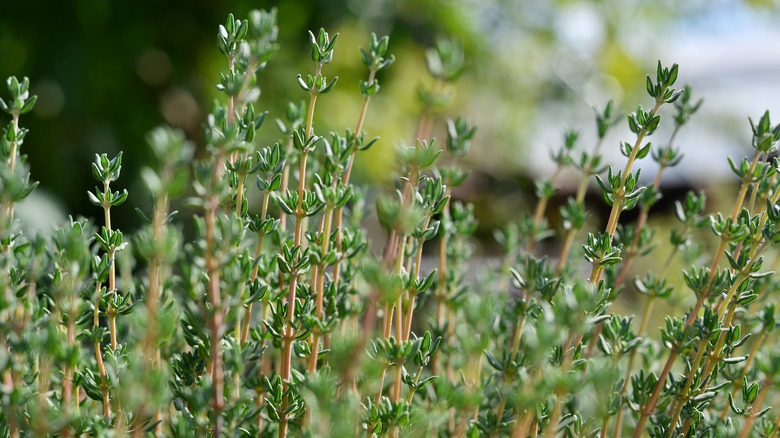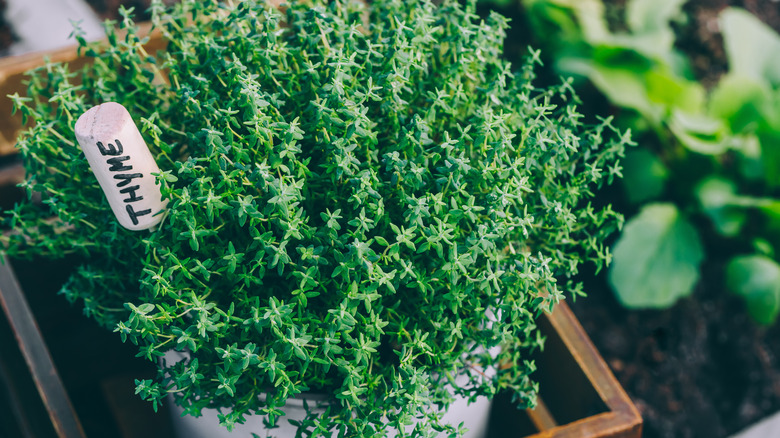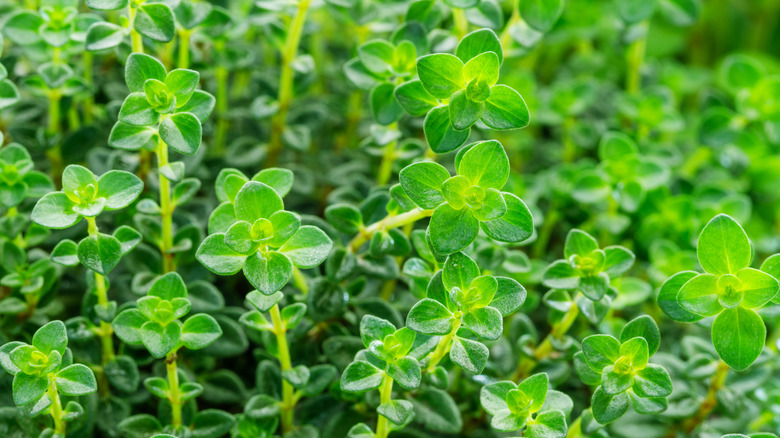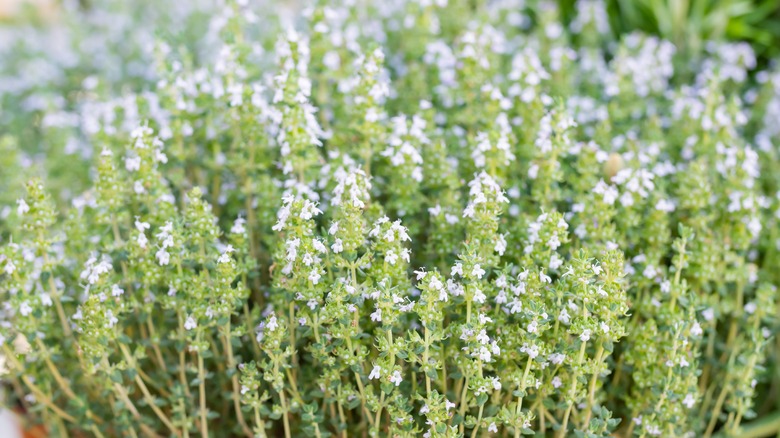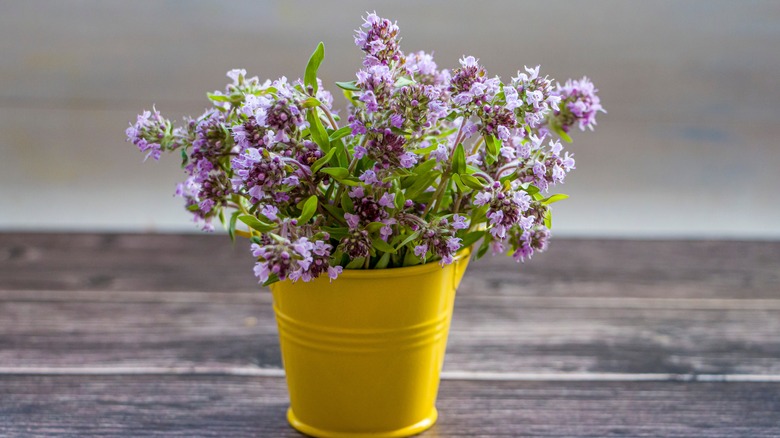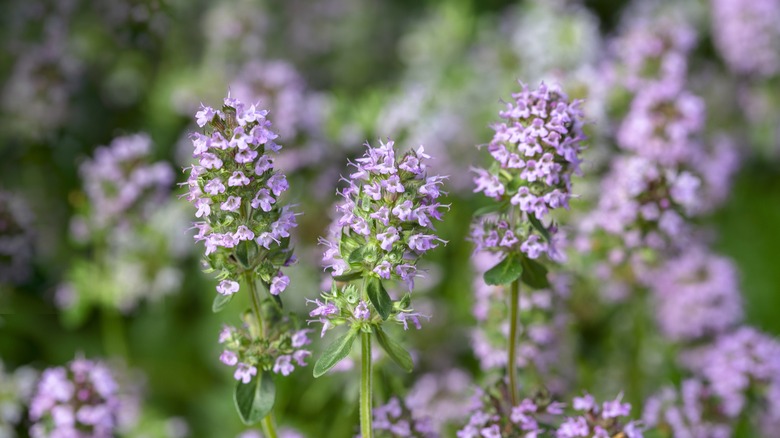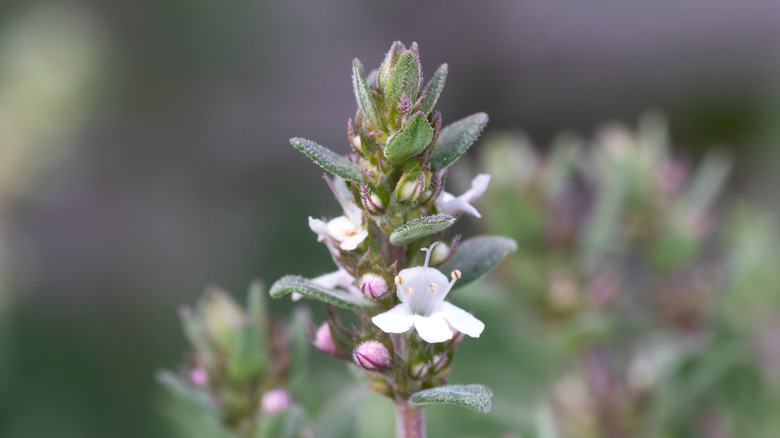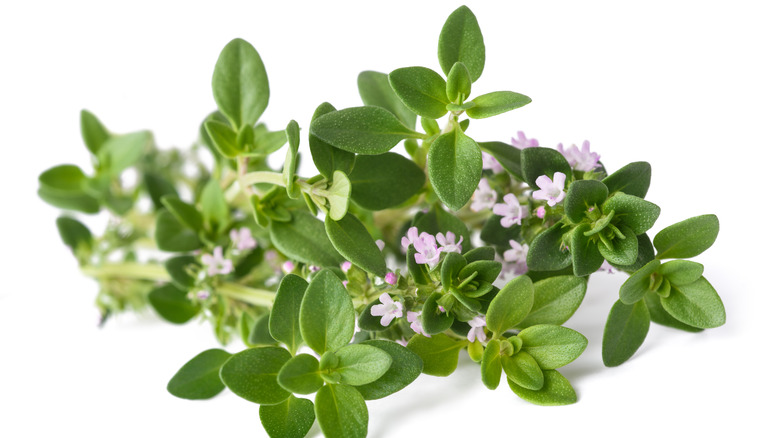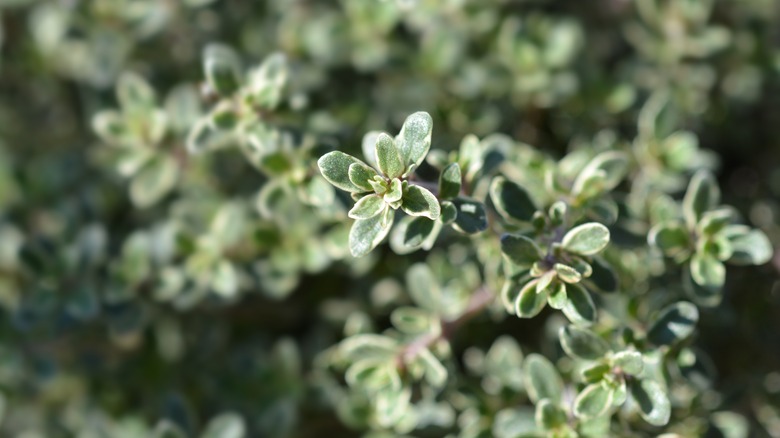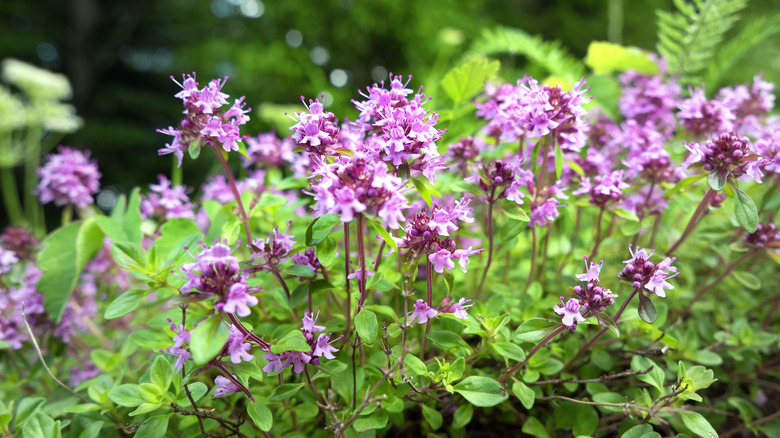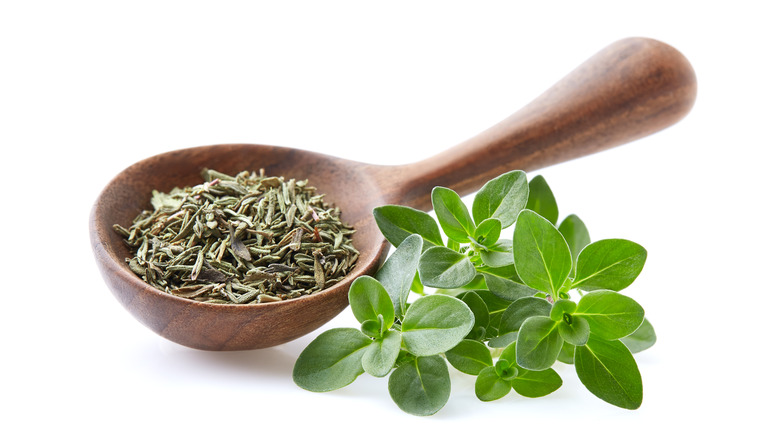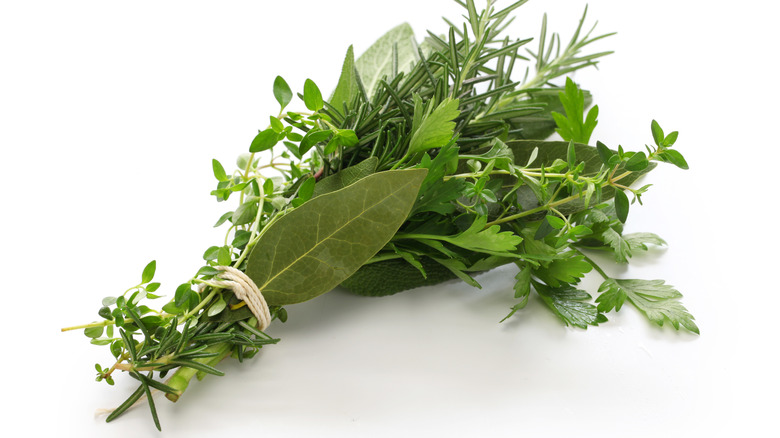11 Varieties Of Thyme, Explained
Whatever your particular cooking specialty, thyme is one of those must-have herbs in the kitchen. Its pungent aroma and flavor, its versatility, and its overall utility in everything from pasta to soups to drinks to even desserts are essential for every chef.
But did you know that "thyme" actually refers to a dozen or more varieties of the herb? What we commonly call thyme is typically shorthand for a particularly ubiquitous kind — common thyme — which is an important one, but hardly the only variety of the plant. To truly know your herbs, it's important to gain some familiarity with thyme's many, many other types. From lemon thyme to caraway thyme to orangelo thyme, knowing the different iterations of this plant can help you find the perfect choice for your recipe. Whether you use fresh or dried, there may be a lot more to do with thyme than you expect. Read on to learn more about these different varieties of thyme.
Common thyme
If you read "thyme" in a recipe, chances are it is referring to the most typical form of the herb: common thyme. Also known as garden thyme, common thyme is an important perennial herb, and a member of the mint family (per NC State Extension). Its small leaves and strong aroma are easily recognizable, and it plays an important role in countless recipes across diverse cultures. It owes much of its unique strength to thymol, which, according to Encyclopedia Brittanica, is fundamental in its essential oil.
Thyme is a savory herb and is frequently used in meat recipes, like this bone-in rib eye with garlic, rosemary, and thyme, as well as in beef stew. Thyme also works well in pasta and adds crucial flavor to mushrooms. But thyme can also work in less traditional ways. For instance, it can add a refreshing herbal element to a thyme-infused wine punch.
Common thyme can be used fresh and dry, and is not particularly difficult to grow if you have the space. If you can't grow it, though, common thyme it can often be found fresh in grocery stores, and can always be stored dry for long periods.
Lemon thyme
Lemon thyme is another very common variety of the herb that, as the name suggests, has a citrusy and lemon-like flavor. Lemon thyme is a Mediterranean herb, and like its close relative common thyme, is relatively easy to grow at home. In fact, if you do have the space, growing it — and other specialty varieties of thyme — can be pretty handy, because less common varieties become harder to find in stores. Lemon thyme likes growing conditions that are reminiscent of its Mediterranean origins (rocky, sandy soil) but is pretty hardy and adaptable, provided it gets enough light and isn't overwatered.
Whether you're able to grow it or not, having a sense of its utility is important. After all, why not just use common thyme? While the two varieties can sometimes be swapped for each other in practice, the citrusy flavor of lemon thyme is very distinct, and common thyme just can't fully capture it. Consider trying it in these lemon thyme bars or lemon thyme croutons (both technically call for common thyme, though lemon thyme will only heighten the flavors).
French thyme
Despite its small size and petite leaves, thyme is potent, and can sometimes even become a little bit overpowering in recipes. If that has been the case for you in the past, you might want to look into French thyme. It is another fairly common variety of the herb, and according to the New York Botanical Garden, it has especially narrow leaves and an overall sweeter flavor than traditional common thyme. French thyme can work well in everything from salads to soups to anything in between and is worth experimenting with to find how it compares to other thyme varieties.
If you have the opportunity to grow it, it's important to be considerate of its unique qualities. Given its sweeter, milder flavor, it is unsurprisingly a little less hardy than other forms of thyme, particularly when it comes to cold temperatures. Accordingly, French thyme is also sometimes given the name "summer thyme" (per Pinetree Garden Seeds)."
German thyme
French thyme is not the only variety of the herb named after a country. Another common nationality-themed version is German thyme. Per My Garden Life, German thyme, like other types of thyme, can be used widely in salads, soups, sauces, marinades, and more — including tea, in which it is particularly good.
What makes this variety unique is that it tends to be a little hardier than common thyme. If you're a gardener, you know this means that it can withstand colder temperatures and may have more frost resistance than varieties like French thyme — which is perhaps unsurprising from the name, given the generally colder temperatures in Germany relative to much of France. In fact, according to Gardener's Path, German thyme is also sometimes called "winter thyme." Notably, the leaves are also more rounded than with common thyme, and unlike both that variety and French thyme, it does not have a red stem.
Caraway thyme
Caraway thyme is a particularly unique version of the herb with which all chefs should have familiarity. As the name suggests, what sets this variety apart flavor-wise is a slight caraway note to the leaves. According to NC State Extension, caraway is noted for its pointy and dark green leaves and, perhaps most notably, its very attractive pink flowers in summer. The herb is native to Sardinia and Corsica, two islands in the Mediterranean sea, and has traditionally been used for culinary and medicinal purposes.
Caraway thyme has an interesting botanical name (Thymus herba-barona) and according to the New York Botanical Garden, this refers to its use in an English roast called "The Baron." Given that this herb has a particularly unique flavor, it's a good idea to try it out in small amounts at first to get a sense of its flavors and what it brings to a dish.
Orange balsam thyme
Lemon thyme is not the only thyme variety with a citrusy element. If oranges are more your thing, consider orange balsam thyme. This highly unique variety of the herb — and an interesting alternative to lemon thyme — has a notably fragrant orange scent. According to the Missouri Botanical Garden, orange balsam thyme leaves are most aromatic shortly before they flower, so that's when you want to pick the leaves, regardless of whether you intend to use them fresh or dry them out and save them for later.
Given the challenges of finding relatively exotic forms of thyme, if you have the space (even a sunny windowsill), your best bet may be growing it at home. This one grows pretty easily, potentially reaching up to a foot tall. And like other thyme varieties, there are plenty of possibilities for use — salads, meat dishes, sauces, and more are all options. Just consider where a little citrusy flavor would bring something exciting to a dish.
Orangelo thyme
Believe it or not, orange balsam thyme isn't even the sole type of thyme with an orange scent. According to Baker Creek Heirloom Seeds, another variety to explore is orangelo thyme. In fact, its Latin name (Thymus fragrantissimus) gives you a pretty good idea of how aromatic it can be.
What's the difference between orangelo and orange balsam thyme? Truthfully, if you are able to find either one reliably, you're in luck. But, according to Burpee Seeds, orangelo is distinguished by being a newer variety, and may potentially be a little easier to grow for beginner gardeners.
As with other aromatic herbs, you really can't beat enjoying orangelo thyme when it's fresh (which, again, should be just before it flowers). But like other thyme varieties, this can retain strong flavors even when dried, and so can be harvested and saved for later. Looking for something to try orangelo thyme in? Consider substituting it for common thyme in this raspberry-thyme shrub, to give it an extra-citrusy quality.
Silver queen thyme
Silver queen thyme does not necessarily sound like it would be citrusy, and yet it is another thyme variety with distinctly lemony notes. According to Gardenia, silver queen thyme has small, silver-edged leaves (which is where the name comes from). In terms of how to use it, silver queen thyme is a pretty good substitute for lemon thyme and other citrusy versions of the herb, perhaps working well in this recipe for roasted lemon chicken or this chicken recipe that features a lemon thyme marinade. It also will make a great thyme tea.
In terms of how it grows, silver queen thyme is somewhat unique. It's particularly bushy, and many gardeners choose to use it as a type of ground cover. Leaves are ideally picked before flowering, but the plant's attractive mauve flowers will attract pollinators. Notably, this variety received an award from the Royal Horticultural Society, according to Gardenia.
Creeping thyme
"Creeping" plants tend to be low-growing and vining, and accordingly are good for ground cover. Some creeping plants are ornamental and inedible, but some, like creeping thyme (and many other thyme varieties) are completely edible.
Per Gardening Know How, creeping thyme, or "Mother of Thyme," is a slightly minty variety of the herb that can be used fresh or dried, and, like other varieties, works well in everything from salads to soups to sauces to marinades. Its "creeping" quality makes it especially good for gardeners, serving as attractive (and don't forget, edible) ground cover, as well as a good border for gardens and pathways. Don't worry about deer, because this variety is considered deer-resistant. And once it flowers, it is likely to attract plenty of pollinators.
While thyme is not always used as therapeutically as it once was, this excellent variety can certainly meet many of your culinary needs.
Pennsylvania Dutch tea thyme
Thyme is frequently used to flavor countless different types of food. But as noted in many of the varieties above, thyme leaves can also make a wonderful herbal tea. The benefits of thyme tea are real: According to Well+Good, thyme tea can help relieve anxiety and is high in vitamins A and C, as well as copper and other minerals. It also has antioxidants, and it may even have antibacterial and antifungal properties. Not bad for such tiny leaves!
While many varieties of thyme can make a great tea, Pennsylvania Dutch tea thyme is almost specifically designed to do that. Per Mountain Valley Growers, this type of thyme has large, very green leaves with a strong scent. It can be used fresh or dried. To get a little creative, consider mixing it with other herbs (like mint varieties) to find a blend that you enjoy.
Oregano thyme
Some recipes call for quite a few herbs, and carefully measuring and apportioning them out can sometimes be a little tedious. One remedy to this is something called bouquet garni. A bouquet garni (or garnished bouquet) is a French cooking ingredient consisting of a bundle of herbs, typically tied together with twine and contained in cheesecloth, and is used in sauces, soups, and other dishes. While parsley, thyme, and bay leaves are typically included in a bouquet, those are not the only herbs you'll find. Oregano and others can easily be added, depending on what your interest is.
On that note, one final variety of thyme to mention is oregano thyme. As the name indicates, oregano thyme has flavors reminiscent of both thyme and oregano (per Oakland Nurseries), which makes it a helpful shorthand when cooking. It's not quite as complex as a true bouquet garni, but is sufficient to add herby flavors to whatever you're making. Its dark green leaves and pink flowers make it very aesthetically attractive as well.
